In Photos: The Science and Silliness of the 2017 Ig Nobels
Setting the stage
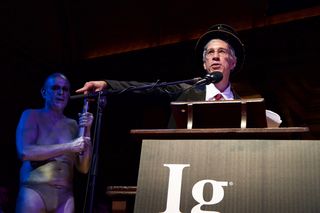
On Sept. 14, 2017, the 27th First Annual Ig Nobel Prize Ceremony celebrated unconventional research, delivered 24-second scientific lectures and presented a mini-opera about incompetence. You know...the usual.
The nearly-two-hour event played to a packed house at Harvard University's Sanders Theatre, where the appreciative audience laughed and applauded scientific achievements that were somewhat more unorthodox than most.
In case you were wondering, the ceremony is identified as both the 27th and the first because "every year is a new beginning," founder and master of ceremonies Marc Abrahams, editor of the science magazine Annals of Improbable Research, told Live Science in 2016.
Keeping the beat
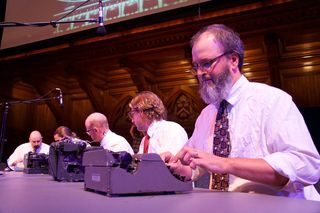
The Ig Nobels kicked off with a pre-ceremony typing concert by the Boston Typewriter Orchestral, an eight-person ensemble that performed rhythmic selections by pounding manual typewriters' clacking keys, dinging their return carriage bells, and even slapping the typewriters' bodies.
Plane and simple
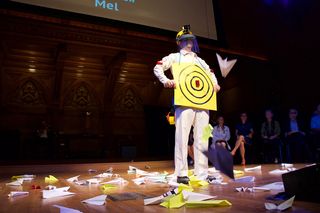
Audience participation during the Ig Nobels is a vital part of the evening's "Paper Airplane Deluges," which occur at two designated periods during the ceremony — one at the start and one at the midpoint. Airplanes must be paper only, unadorned and unaugmented by weights or props of any kind. They are flung "profusely and to the point of deluge," according to the IgBill program, in the general direction of the designated Human Aerodrome, Eric Workman, who also created the Ig Nobel prizes and the evening's props.
Illuminated laureates
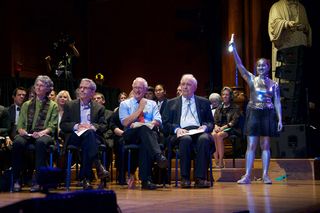
The Ig Nobel prizes were distributed by Nobel laureates, who were seated front and center on the Sanders Theatre's stage. This year's presenters were Eric Maskin (economics, 2007), Oliver Hart (economics, 2016) and Roy Glauber (physics, 2005). They were illuminated by one of the Ig Nobels' "Human Spotlights," Madeline Pelz, a doctoral candidate in the Early Childhood Cognition Lab at MIT.
Ain't she sweet
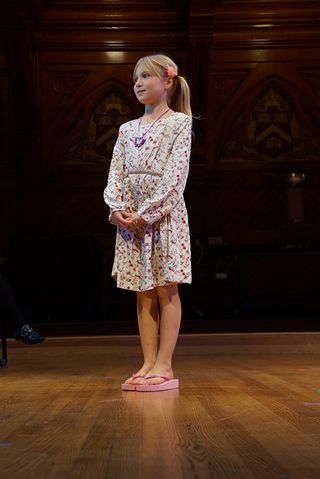
To make sure that the winners of the Ig Nobel prizes didn't overstay their welcome onstage, "Miss Sweetie Poo" (Dorothea Hartig) allowed each winner 60 seconds of talking, before walking out and repeating "Please stop, I'm bored!"
Sign up for the Live Science daily newsletter now
Get the world’s most fascinating discoveries delivered straight to your inbox.
Behind the podium
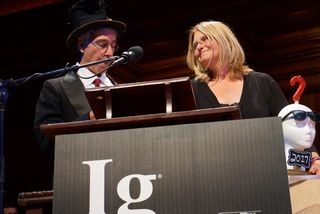
Master of ceremonies Marc Abrahams kept the evening on track, and science writer Karen Hopkin narrated the mini-opera, and provided impromptu new titles for Abrahams that included "Fun-Size Fajita," "Clever Little Cannoli" and "Tempestuous Taquito."
Fluid felines
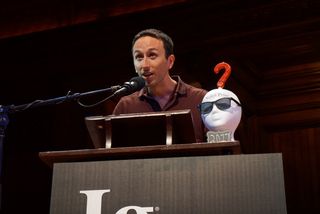
Marc-Antoine Fardin took home the Physics Prize for his study probing the question, "Can a cat be both a solid and liquid?" His research was inspired by cats' uncanny ability to conform their shape to that of any vessel that contains them — a key property of fluids.
Hum a few bars
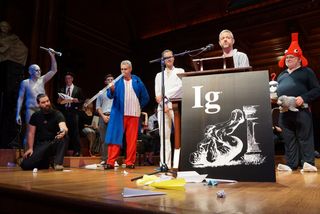
The Ig Nobel Peace Prize went to a team of researchers who discovered that playing the didgeridoo — a wind instrument developed by indigenous people in northern Australia — could successfully treat obstructive sleep apnea and snoring. Alex Suarez, seen here playing a type of didgeridoo, was the first patient to test this hypothesis, and served as the inspiration for the study.
Incompetence arias
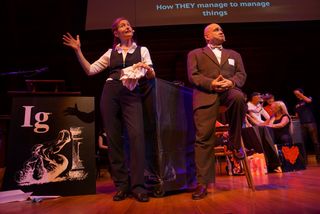
"The Incompetence Opera," with an original libretto by Marc Abrahams and a score composed far in advance of the ceremony by Giacomo Michele Secondo Maria Puccini (1858-1924), John Walter Bratton (1867-1947) and Anon., debuted at the 2017 Ig Nobels. Soloists Maria Ferrante and Ray Bauwens lamented in three acts about how people are promoted until they reach positions of maximum incompetence, and how incapable those clods are of recognizing their own incompetence.
A study with bite
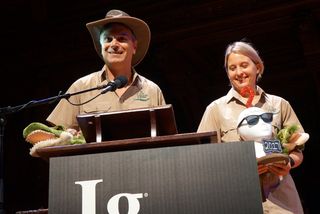
Matthew Rockloff and Nancy Greer, researchers at Central Queensland University in Australia, won the Ig Nobel Economics Prize for their study exploring how interactions with a crocodile could affect a person's affinity for gambling.
Onstage experiment
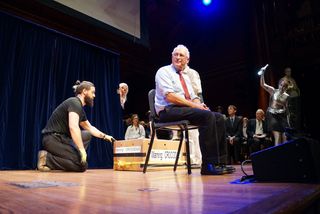
An experiment involving a dubious Oliver Hart, one of the Nobel laureate presenters, and a large box labeled "Warning: CROCODILE" was curtailed before it could be completed, cut short by the Ig Nobels' safety watchdog and "NSFW Indicator Monitor," the noted New York attorney William J. Maloney.

Mindy Weisberger is an editor at Scholastic and a former Live Science channel editor and senior writer. She has reported on general science, covering climate change, paleontology, biology and space. Mindy studied film at Columbia University; prior to Live Science she produced, wrote and directed media for the American Museum of Natural History in New York City. Her videos about dinosaurs, astrophysics, biodiversity and evolution appear in museums and science centers worldwide, earning awards such as the CINE Golden Eagle and the Communicator Award of Excellence. Her writing has also appeared in Scientific American, The Washington Post and How It Works Magazine. Her book "Rise of the Zombie Bugs: The Surprising Science of Parasitic Mind Control" will be published in spring 2025 by Johns Hopkins University Press.












